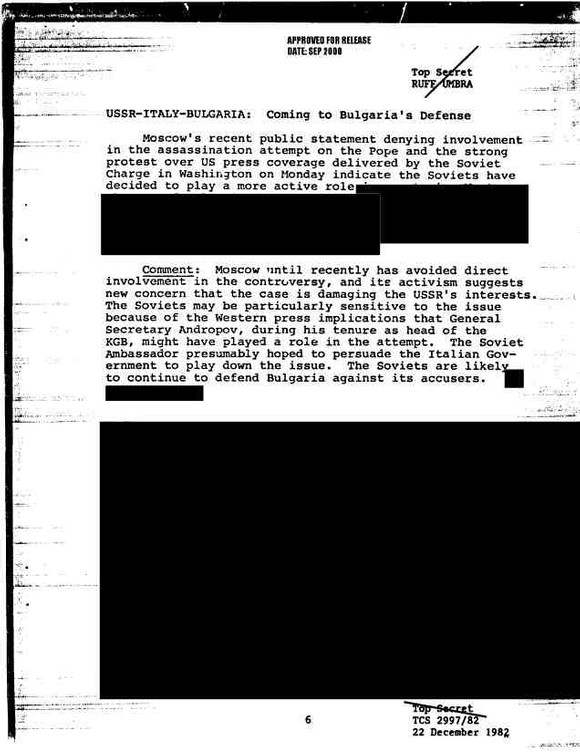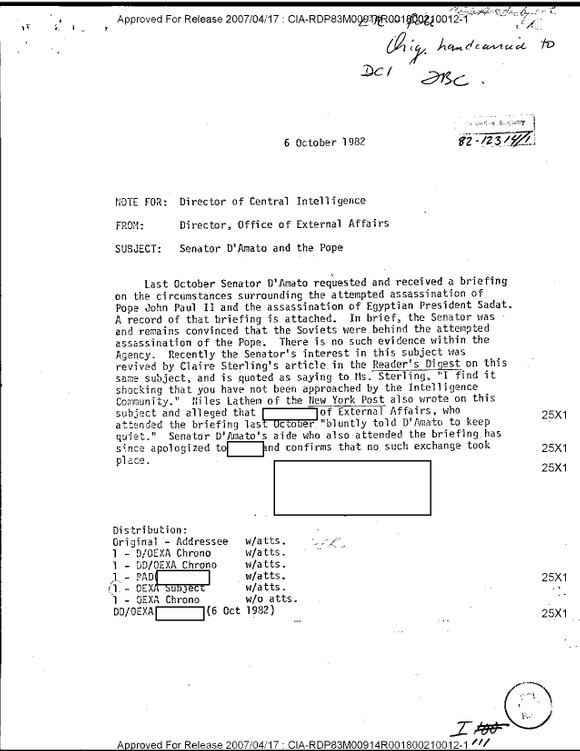Starting from:
$12.95
Pope John Paul II CIA Files - Download
Pope John Paul II CIA Files
980 pages from documents obtained from the CIA relating to Pope John Paul II (Karol Wojtyla). The material chiefly covers the impact of a Polish Pope and the Vatican on Poland; the Solidarity movement; and the Soviet Union. Also, among the documents are briefs and a analysis of the allegations of a Bulgarian conspiracy, in the 1981 assassination attempt on Pope John Paul II. By the Agency. Correspondence with members of Congress show their interest in having allegations of Soviet involvement in the assassination attempt on the Pope probed The files date from 1978 to 2008.
Karol Wojtyla, born on May 18, 1920, became Pope in 1978, taking the name John Paul II. He was the first non-Italian elected Pope since the 1400's. At the age of 58, he was the youngest Pope of the 20th century. On June 2, 1979, Pope John Paul II returned to Poland. Despite Polish laws against religious worship and public gatherings, the Pope held mass in front of one million people in Warsaw's Victory Square, calling for religious freedom. His central message to the crowd was "Don't be afraid."
In 1980, workers in Gdansk, Poland went on strike. The Pope supported the strike and instructed Polish Primate Wyszynski to do the same. This worker's movement became known as Solidarity and launched the Polish struggle against communist rule and Soviet influence. In 1981, the actions of the workers lead to the Polish government declaring martial law. Pope John Paul II publicly denounced the move in his radio broadcasts. It is believed that messages from Pope John Paul II to jailed Polish union leaders, were smuggled in the robes of priests. When in 1982 a priest, Father Jerzy Popieluszko, took a strong public stand against the Polish regime, he received encouragement from the Pope. Popieluszko's actions, such as participating in sit-ins, lead to Polish Communist officials having him murdered. The events sparked by Solidarity lead to Poland becoming the Eastern Bloc's first freely elected government.
On May 13, 1981, Pope John Paul II was shot while riding through St. Peter's Square, by a Turkish fugitive named Mehmet Ali Agca. Agca, a member of the right-wing Turkish group the Grey Wolves, had escaped from a Turkish prison where he was being held for the murder of a left-wing writer, Abdi Ipekci. Agca had previously sent letters threatening the life of the Pope. Agca first told the authorities that he was acting for the Bulgarian intelligence service. Italian investigators pursued the allegation, that the attempt on the Pope's life was a conspiracy. Their belief was that the Soviet Union, instructed the Bulgarian secret police, to hire Agca to assassinate Pope John Paul II. Trials succeeding the conviction of Agca of alleged co-conspirators failed to gain convictions
In 2000, Italian President Carlo Azeglio Ciampi issued a pardon to Agca. Pope John Paul II, who meet with Agca three days after being shot, was in favor of clemency for Agca. Agca was returned to Turkey, where his death sentence for the murder of Ipekci , which was handed down in absentia, was commuted to 10-years of imprisonment. During a May 2002 visit to Bulgaria, Pope John Paul II told Bulgarian President Georgi Parvanov that he never believed allegations that there was a Bulgarian conspiracy.




980 pages from documents obtained from the CIA relating to Pope John Paul II (Karol Wojtyla). The material chiefly covers the impact of a Polish Pope and the Vatican on Poland; the Solidarity movement; and the Soviet Union. Also, among the documents are briefs and a analysis of the allegations of a Bulgarian conspiracy, in the 1981 assassination attempt on Pope John Paul II. By the Agency. Correspondence with members of Congress show their interest in having allegations of Soviet involvement in the assassination attempt on the Pope probed The files date from 1978 to 2008.
Karol Wojtyla, born on May 18, 1920, became Pope in 1978, taking the name John Paul II. He was the first non-Italian elected Pope since the 1400's. At the age of 58, he was the youngest Pope of the 20th century. On June 2, 1979, Pope John Paul II returned to Poland. Despite Polish laws against religious worship and public gatherings, the Pope held mass in front of one million people in Warsaw's Victory Square, calling for religious freedom. His central message to the crowd was "Don't be afraid."
In 1980, workers in Gdansk, Poland went on strike. The Pope supported the strike and instructed Polish Primate Wyszynski to do the same. This worker's movement became known as Solidarity and launched the Polish struggle against communist rule and Soviet influence. In 1981, the actions of the workers lead to the Polish government declaring martial law. Pope John Paul II publicly denounced the move in his radio broadcasts. It is believed that messages from Pope John Paul II to jailed Polish union leaders, were smuggled in the robes of priests. When in 1982 a priest, Father Jerzy Popieluszko, took a strong public stand against the Polish regime, he received encouragement from the Pope. Popieluszko's actions, such as participating in sit-ins, lead to Polish Communist officials having him murdered. The events sparked by Solidarity lead to Poland becoming the Eastern Bloc's first freely elected government.
On May 13, 1981, Pope John Paul II was shot while riding through St. Peter's Square, by a Turkish fugitive named Mehmet Ali Agca. Agca, a member of the right-wing Turkish group the Grey Wolves, had escaped from a Turkish prison where he was being held for the murder of a left-wing writer, Abdi Ipekci. Agca had previously sent letters threatening the life of the Pope. Agca first told the authorities that he was acting for the Bulgarian intelligence service. Italian investigators pursued the allegation, that the attempt on the Pope's life was a conspiracy. Their belief was that the Soviet Union, instructed the Bulgarian secret police, to hire Agca to assassinate Pope John Paul II. Trials succeeding the conviction of Agca of alleged co-conspirators failed to gain convictions
In 2000, Italian President Carlo Azeglio Ciampi issued a pardon to Agca. Pope John Paul II, who meet with Agca three days after being shot, was in favor of clemency for Agca. Agca was returned to Turkey, where his death sentence for the murder of Ipekci , which was handed down in absentia, was commuted to 10-years of imprisonment. During a May 2002 visit to Bulgaria, Pope John Paul II told Bulgarian President Georgi Parvanov that he never believed allegations that there was a Bulgarian conspiracy.




1 file (67.9MB)



